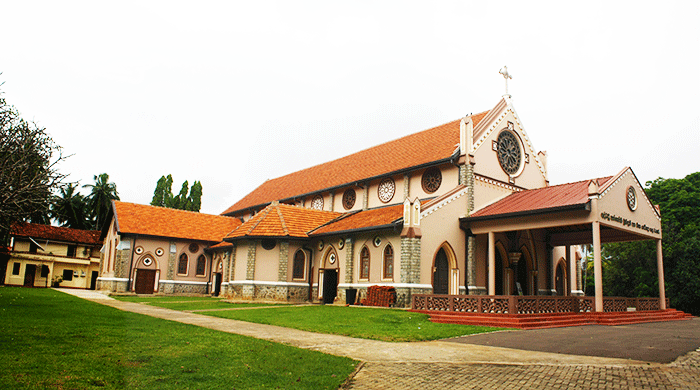WAHAKOTTE CHURCH
The hands of St. Anthony of Wahakotte church had protected the people in the area over the past 400 years through the miraculous power. In relation to St, Anthony they have ancient handwritten prayers and hymns the village, crops, exorcise and invoke divine assistance.
Wahakotte church is one of the important tourist attractions in Kandy but not includes in the most trips to Kandy, because it is a little bit off the town. Kandy is one of the most visited cities, which harbours a large number of important tourist places. There is hardly any Sri Lanka trip without an overnight stay in Kandy. Most popular trips such as 7 days classical tour, 5 days Sri Lanka cultural tour includes Kandy.
However, it is well-worth of investing time to explore this beautiful historic church. It may be a daunting task to add Wahakotte church to the one Day Sri Lanka trip and a 2 days Sri Lanka trip to Kandy or 3 days Sri Lanka trip to Kandy allows the travellers easily visit Wahakotte church from most cities, Sri Lanka.
Scattered across Sri Lanka, from northernmost tip of Sri Lanka “Jaffna” to southernmost tip of Sri Lanka “Dewundara”, thousands of Churches serve a large number of Christian and catholic devotees on their way to finding the eternal bliss.
But most of these churches do not hold the historical and religious importance of Wahakotte Church, which sits in the hill-country capital of Kandy. One of the very important pilgrimage sites for Christians in Sri Lanka.
IMPORTANCE OF WAHAKOTTE CHURCH AS A TOURIST ATTRACTION IN KANDY
Wahakotte is a well-known pilgrim centre, enshrining a miraculous statue of St. Anthony of Padua (Italy), is among the important places to visit in Kandy. St Anthony is a Catholic Saint, born in 1195 in Lisbon (Portugal). At the age of 15, he entered the Augustinian Order and lived like a monk. But desiring to be a missionary he later joined the Franciscan Order and went to Morocco. Due to ill health, he was forced to return to Italy, where he became a famous preacher and wonder-worker.
MIRACLE OF ST.ANTHONY
There are thousands of recorded miracles attributed to St. Anthony during his lifetime and also after his death. He died in Padua, on 13th of June 1231 and Catholic celebrates his ‘feast’ on that day. Even after seven centuries, his tongue is miraculously preserved at Padua for public veneration as a sacred object. Eve non-Christian acknowledge that they have received favour by invoking his help.
The hands of St. Anthony had protected the people in the area over the past 400 years through the miraculous power. In relation to St, Anthony they have ancient handwritten prayers and hymns the village, crops, exorcise and invoke divine assistance. Often the Muhuppu (the chef laymen elected by the parish council especially to lead prayers and hymns and to be responsible for parish activities) recite these prayers as a special privilege and as a sign of living under the protection of St. Anthony. There are instances that help of St. Anthony is sought in order to inflict damage to others.
The name “Wahakotte” means, according to some villagers “the castle gate” (Wasala Kotte) and the village were so-called because it protected a palace, trace of which are still visible. Some others say that “Wahakotte” means poisonous pillow (waha-poison; Kotte=pillow) as a queen had committed suicide after hearing of her husband’s death at war. There is a legend to say that in 194 BC when King Dutugemunu defeated Elara, he built a small fortress at Wahakotte.
HISTORY OF WHAKOTTE CHURCH
There are ruins of some ancient buildings on a rocky hill called Maligatenna (palace field) or Bagankotte. Wahakotte is so situated that one can observe the approaching enemy, even as far as the rocks of Dambulla towards Anuradhapura. However, there were royal connections to this village from the fact that some still pay a tax to Dahawa temple for the use of their paddy-fields.
It is difficult to find out, whether they were Nindagam (belonging to aristocrats), Devalagam (belonging to the temple) or even Gabadagam (royal property). But some historical information reveals that earlier they paid tax to the royal ambassador, but later it was transferred to the temple.
Famous historian S.J, R, Rodrigo, begins his accounts on the history of Wahacotte with reference to 1582 when Rajasinghe of Sitawaka waged war against Kandy. At the time of this war, Karaliyadde Bandara fled to Trincomalee and died there of smallpox. Before his death, he became a Christian and entrusted his daughter Dona Katharina and Yamsinghe to the Portuguese.
Yamsinghe too became a Christian at Goa under the name of Don Phillip. When the Kandyan began to oppose king Rajasinghe, Don Philip returned to Sri Lanka and was crowned at Wahakotte by the Portuguese.
After the death of Don Philip, Konappu Bandara seized the Kingdom of Kandy forcing Don Juan, the son of Don Philip, to flee. He fled, first to Wahakotte and via Goa to Portugal, where he became a priest.
Konappu Bandara married Dona Katherina in order to consolidate his position as a king. Wahakotte was frequented by all those who had contacts with the Portuguese during this period, due to the fact that the route from Kandy to Trincomalee and Mannar was through Wahakotte.







